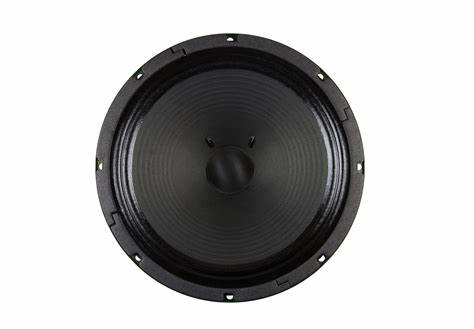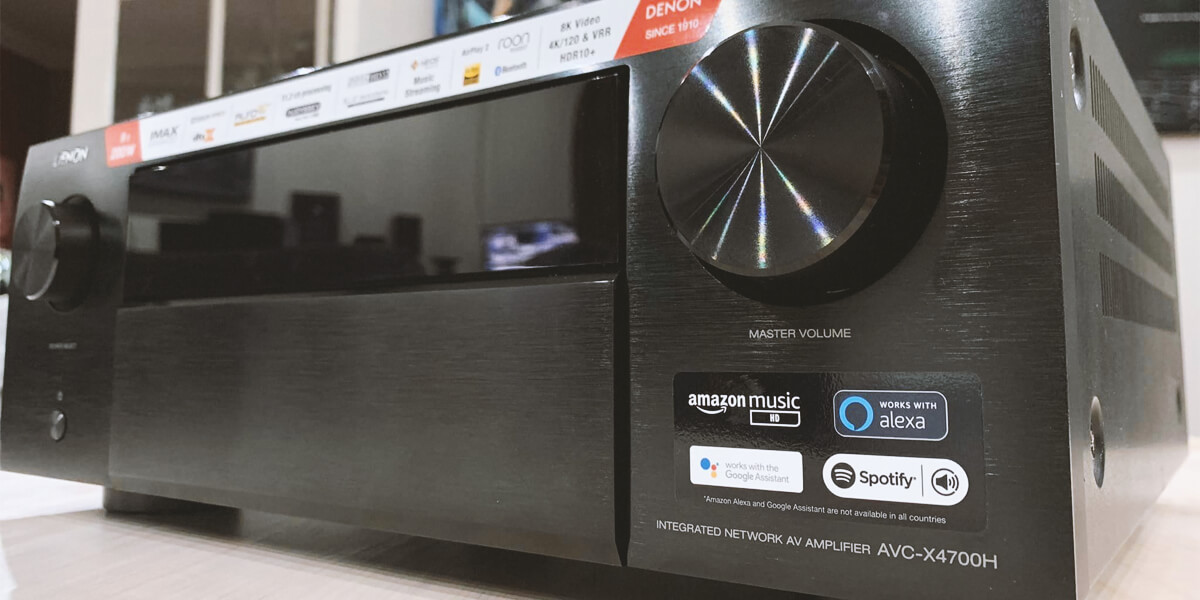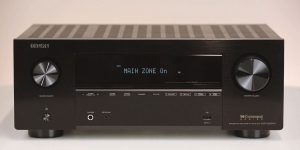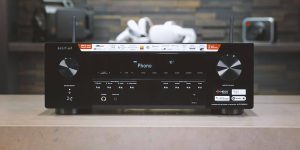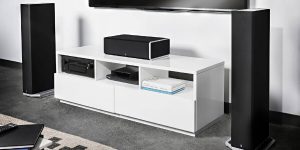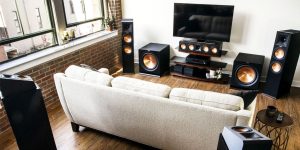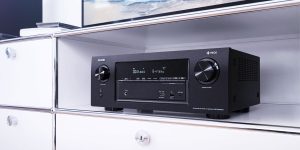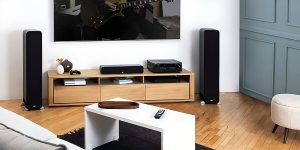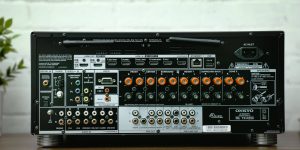Getting a multichannel surround sound receiver was a blue dream once, but these days this dream can come true for anyone. One no longer needs to attend a cinema to get multichannel surround sound. Household AV receivers have become real game changers allowing them to build an advanced home cinema and entertainment systems. Today, 9 channel receivers are the most popular among users due to their price and performance. That is why I decided to tell you more about them and help you choose the right device.
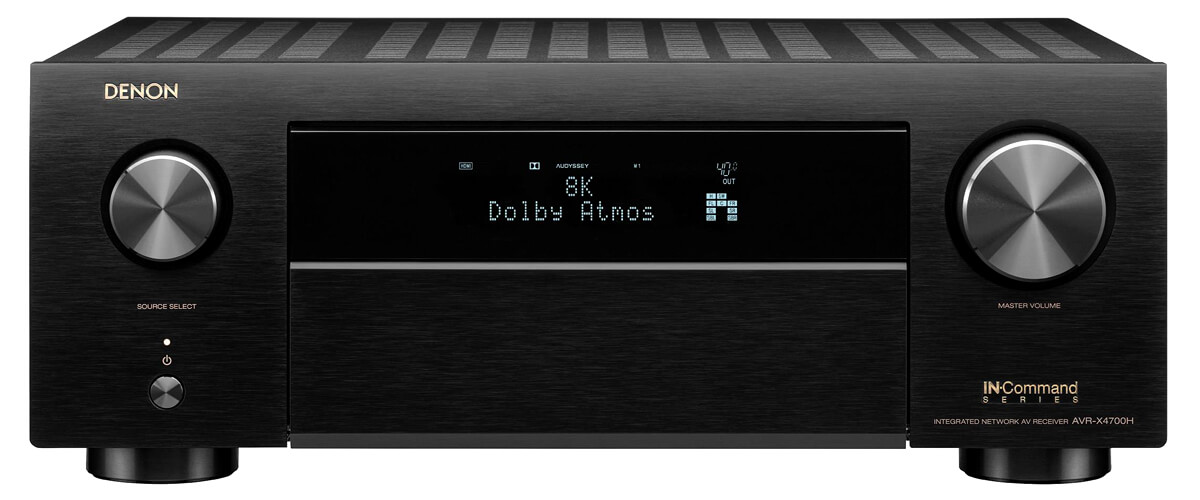
Nowadays, the market is filled with surround sound receiver options, but what is the best 9-channel AV receiver? I have got my hands on several 9-ch receivers from Denon, Yamaha, Marantz, and Onkyo to find the coolest option that can become a tireless heart of any home entertainment or cinema setup.
9 channel AV receiver comparison table
| Name | Channels | Power output | HDMI in/out | Bluetooth/Wi-Fi | Review |
|---|---|---|---|---|---|
| Denon AVR-X4700H best overall | 9.2 | 125W/8 Ohm, 165W/6 Ohm | 8/3 | yes/yes | Review |
| Marantz SR7015 also a great choice | 9.2 | 125W/8 Ohm, 165W/6 Ohm | 8/3 | yes/yes | Review |
| Onkyo TX-RZ50 budget | 9.2 | 120W/8 Ohm, 250W/6 Ohm | 7/2 | yes/yes | Review |
Best 9 channel AV receiver reviews
Denon AVR-X4700H – best overall

While the AVR-X4700H wasn’t the first receiver I tested, it stole a special place in my heart. So, I wanted to put one of Denon’s receivers first. It is a 9.2 channel unit with 125 watts per 2 channels with 8 Ohm speakers, 0.05% THD, and classic 20-20Hz. Furthermore, the receiver also works with 4 Ohm speakers. This amount of power allowed me to fill 2 medium-sized rooms with immersive and quality sound without any problem.
A total of 8 HDMI ports with the latest HDCP technology support 4K at 140 Hz. Three ports work with 8K content at 60 Hz. The receiver has eARC, which furthermore increases the quality of the media. It has a very efficient upscaling capability. My old 1080p Blu-ray movies looked stunning in 8K.
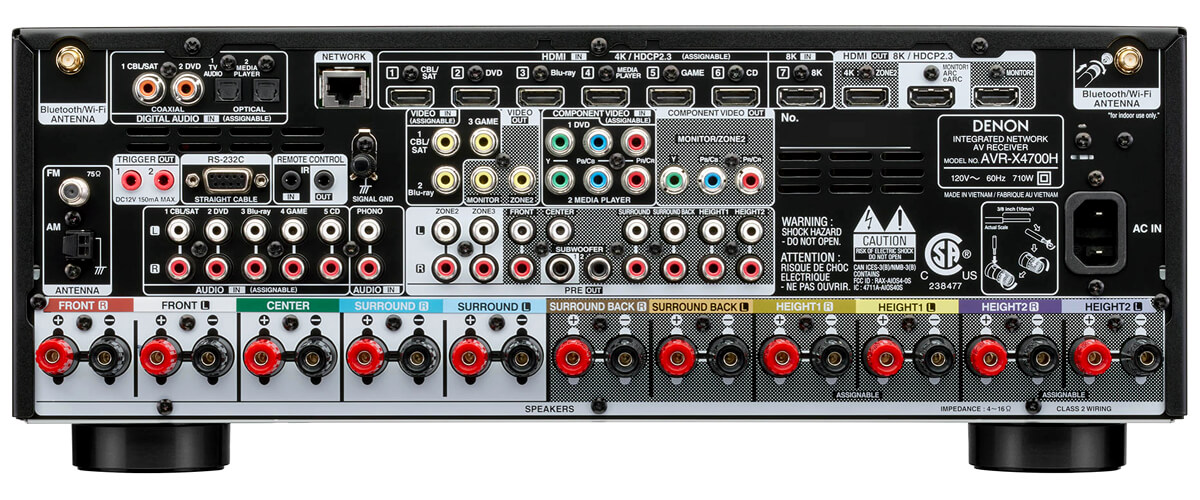
The unit supports modern Dolby technologies, including Dolby Atmos, DTS Virtual:X, DTS:X, and IMAX Enhanced. The receiver effectively handled my far-from-cheap home theater system, letting them shine in all the quality one can get. I didn’t find a single flaw, either in the music or the movies. The biggest problem was choosing which mode I liked the most.
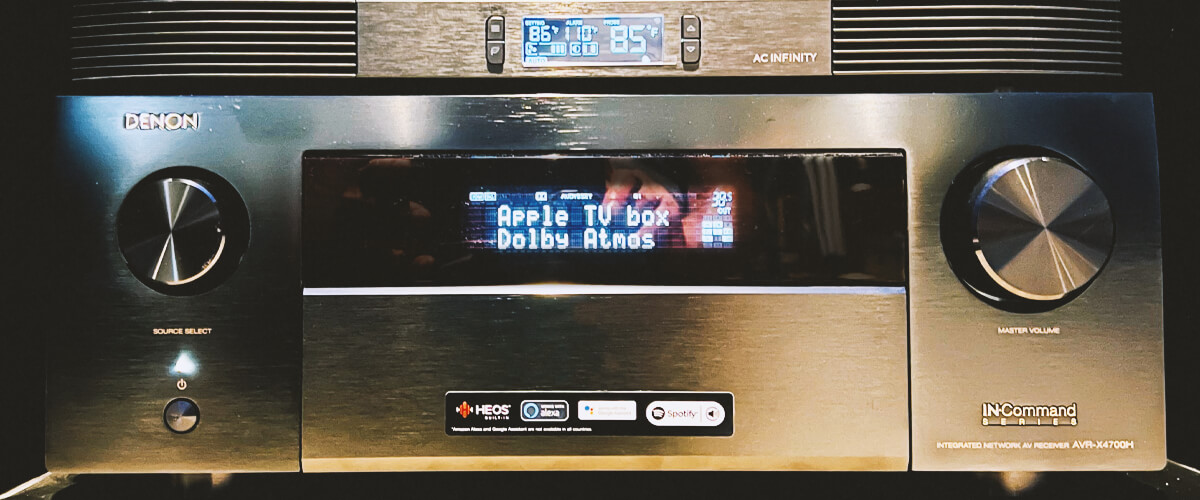
Usually, such high-end receivers are pretty hard to operate for those new to the receiver industry, as with Marantz SR6015. But this is not the case with AVR-X4700. The manufacturer stated that the receiver supports Audyssey MultEQ XT32, which is not surprising, but what is more important is how it works and how easy it is to work with the menu of this unit. I let my wife test the autocorrection feature and watched how much time it took her to handle this task. Even though she always trusts me with setting up, tuning, and installing our home cinema setup and typically enjoys the result, it took her several minutes to make the AVR-X4700H set itself.
The AVR-X4700H is a very flexible unit—whether you want to build a single-room immersive setup or desire to create two individual zones, watch movies, play games or even listen to music, the receiver has it all! Despite a rich set of features and capabilities, Denon managed to create an efficient menu allowing one to manage multiple devices conveniently. Knowing Denon’s history and the astonishing quality of the AVR-X4700H, I can expect it to last for many years to come, serving as the hardest of any home entertainment system and pleasing even the most demanding users.
Key specs
- Channels: 9.2.
- Power output: 125W/8 Ohm, 165W/6 Ohm.
- HDMI inputs/outputs: 8/3.
- Video functions: 8K/60Hz, 4K/60Hz, 4K/120Hz, HDMI Upscaling up to 8K.
- Bluetooth/Wi-Fi: yes/yes.
- Streaming services: AirPlay 2, Spotify, TuneIn, Deezer, Tidal, Netflix, Amazon Prime.
- Supports: HDR, HLG, HDMI ARC, HDMI eARC, HDMI CEC, HDCP2.3, HDR10+, Dolby Vision, Dynamic HDR.
- Surround sound: DTS:X, DTS Virtual:X, DTS Neural:X, DTS HD Master, Dolby Atmos, Dolby TrueHD, Dolby Atmos Height Virtualization, Dolby Surround, Auro-3D, IMAX Enhanced, Multichannel stereo.
Pros
- Astonishing flexibility and performance.
- A rich set of modern features.
- Well-designed and quality-built chassis.
Cons
- A proprietary calibration App is available only with a charging fee.
- The remote control could have been backlit.
Marantz SR7015 – also a great choice
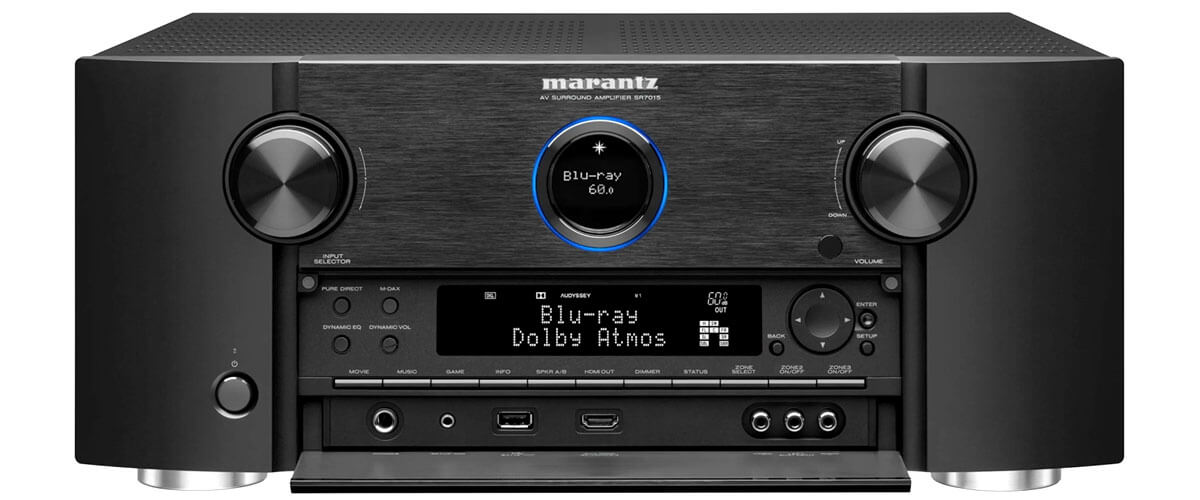
The Marantz SR7015 uses nine high-current discrete power amplifiers and can provide 125 watts with 8 ohms speakers, 20Hz–20kHz, 0.05% per two channels. The AV amplifier can drive low-impedance speakers, making it sound more balanced. The SR7015 features patented HDAM (Hyper Dynamic Amplifier Module), current feedback technology, and advanced AKM AK4458 32-bit D/A converters on all channels. It provides optimal fidelity, resulting in a wider dynamic range and reduced distortion.
Just like the AVR-X4700H from Denon, the SR7015 is filled with numerous features. This 9-channel receiver offers the latest Dolby Atmos technologies, including fancy DTS:X. Interestingly with the Auro-3D, the device can process up to 11 channels. There is more, as the SR7015 is IMAX Enhanced certified. The device also features enhanced eARC technology and supports HDR10+, together with older technologies and HLG and Dolby Vision HD video. For gamers, it offers a 4K at 120 frames per second. It doesn’t stop there.

Thus, similarly to Denon and Yamaha high-end receivers, the SR7015 also has AVRR, ALLM, and popular QFT.
Compared to the older SR6015, the biggest innovation for this model is the presence of an HDMI input and two HDMI outputs that support 8K/60Hz video. The list includes upscaling capability. However, it works a bit worse than the one in the Denon AVR-X4700H. Another important aspect is that when compared to the SR6015, the SR7015 benefits from Auro-3D technology onboard together with improved power. At the same time, the receiver shares many features with the older model from the same product line, the SR8015. Therefore, it is a solid competitor to any other receiver sharing the same price range as the SR7015.

The Marantz SR7015 offers stunning sound quality in movies and music. What’s impressive about it is that it can deliver significant power even when all 9 channels are in use. Such extensive power allows the unit to utilize its full potential, delivering rich, immersive sound. There was no sight of doubt in this receiver’s capabilities regardless of how intensively I used it. In addition, the built-in amplifiers quickly adjust to the action in movies, keeping the sound accurate. All that puts the unit into the list of the best 9-channel receivers.
These mentioned features make the SR7015 a serious competitor to the Denon AVR-4700H. It is especially true since Marantz traditionally surpasses Denon’s AV receivers when playing music. Besides the lack of an FM/DAB tuner, it’s hard to blame it for lacking anything essential. There are plenty of inputs, a classic Marantz design, and supreme chassis quality. The SR7015 sounds precise and detailed, even though it lacks the deepness of the AVR-4700H. 9 amplified channels have significant power, and the surround sound impresses with the fidelity of the effects. The overall performance of the AV amplifier feels consistent, powerful, and confidently controlled.
Key specs
- Channels: 9.2.
- Power output: 125W/8 Ohm, 165W/6 Ohm.
- HDMI inputs/outputs: 8/3.
- Video functions: 8K/60Hz, 4K/60Hz, 4K/120Hz, HDMI Upscaling up to 8K.
- Bluetooth/Wi-Fi: yes/yes.
- Streaming services: AirPlay2, Deezer, Tidal, Pandora, SiriusXM, Napster, SoundCloud, Amazon Music, Amazon Music HD, Mood mix.
- Supports: HDMI ARC, HDMI eARC, HDMI CEC, HDCP2.3, HDR10, HDR10+, Dolby Vision.
- Surround sound: DTS HD Master, DTS Neural:X, Dolby TrueHD, Dolby Surround, Dolby Digital Plus, Dolby Atmos Height Virtualization, Dolby Atmos, Auro-3D, IMAX Enhanced, Multichannel stereo.
Pros
- Great audio quality.
- A rich amount of features.
- Modern HDMI.
Cons
- Only one 8K/60Hz input.
- Lacks built-in tuner.
Onkyo TX-RZ50 – budget
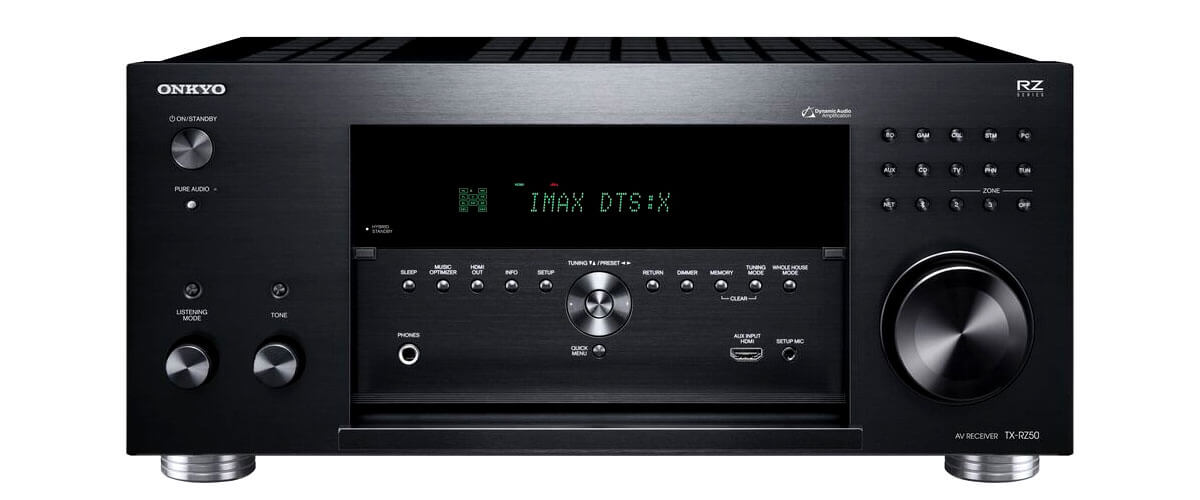
The TX-RZ50 is the cheapest AV receiver in my review. Considering all the state-of-the-art features it has onboard, it has a place in this review and, in some aspects, can compete with the more expensive models. Traditionally for Onkyo, this relatively budget 9.2 receiver is well-made and designed with users in mind. The company’s user-centered approach can be tracked in many aspects, and Onkyo attracted many fans with it.
Returning to the TX-RZ50, Onkyo uses its electric circuit schematics in its product, and this model is not an exception. It has chips designed by Nuvoton Technology and supports 7.2.2 channel surround sound setups. Onkyo’s proprietary intelligent sound processing features are another benefit of this receiver. It brings new life into the old stereo music tracks. Certainly not the main use-case scenario for the receiver, but still a worth noticing feature.
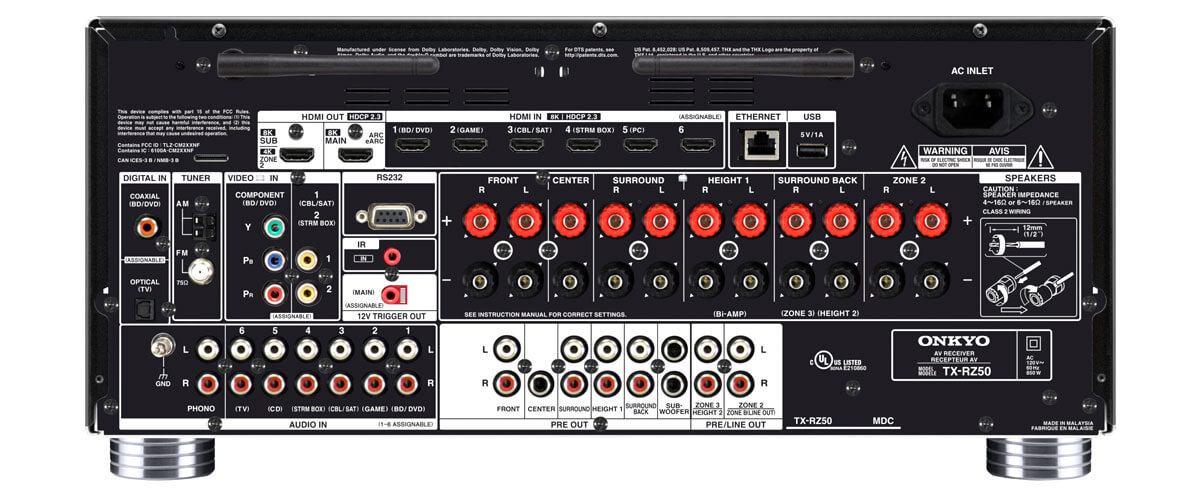
The AV receiver is equipped with seven HDMI inputs and three outputs, supporting HDCP 2.3, all families of HDR10+ technology, Dolby Vision, and Dynamic HDR. 3 HDMI inputs support 8K/60Hz media. The other 3 can work with 4K content at 120Hz. HDMI outs are eARC compatible and work with 3D audio formats such as Dolby Atmos, TrueHD, DTS:X, and DTS-HD Master Audio lossless audio codecs. The receiver can decode and amplify high-bit-rate video together with object-based audio streamed with a Smart TV or smartphone app or with a connected media adapter in their original quality.
The unit pleasantly surprised me with how fast it started. Onkyo installed a high-resolution display into the receiver, which is another benefit, especially concerning the price. Talking about systems and updates, the TX-RZ50 has a capable and easy-to-use app to control the unit. I had the unit without the latest updates, and the receiver installed them automatically once I plugged the Ethernet cable in. But still, I had to reload the receiver manually for the upgraded software to work.
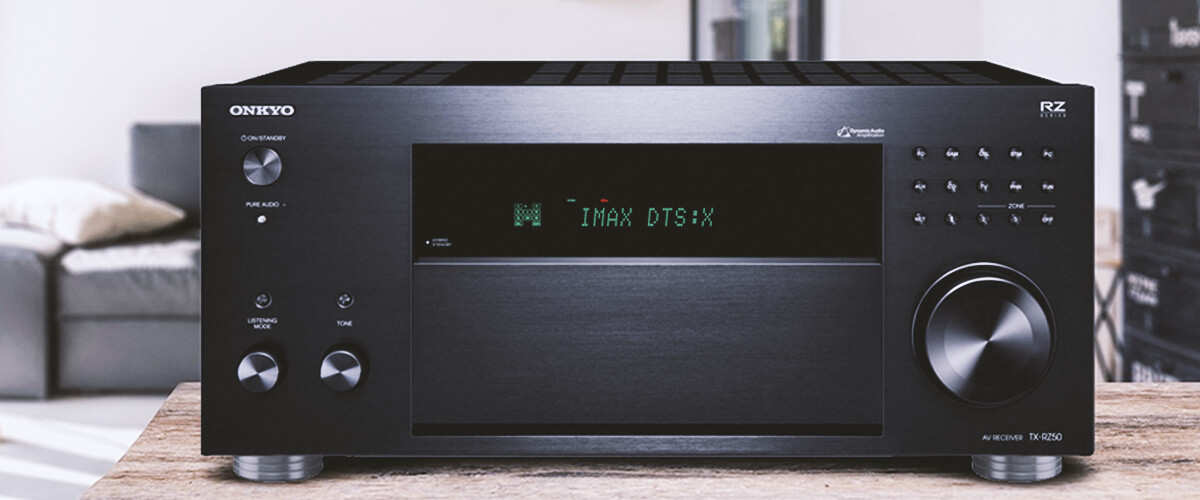
When I listened to music, the TX-RZ50 showed a great balance and capability. Guitar riffs, slow ballads, and vocals are all good. Not perfect, but a very decent result. The dedicated amplifier would do a better job. Anyway, I doubt that even the Yamaha RX-A6A would deliver the same quality. At the same time, due to power limits, the Onkyo showed itself much worse than the Denon AVR-X4700H. Clearly, this results from the huge price gap between the two units. Yet, to my taste, the sound could be a bit more “readable”, especially when the action kicks in and mixes with the dialogue section.
Onkyo made a huge step forward with the TX-RZ50. Perhaps the company doesn’t set new standards in the 9.2 channel AV receiver segment, and this model may lack several features that other receivers mentioned in this review have. At the same time, let’s not forget that this is the cheapest unit on the list. Once again, Onkyo proved that they still have much to say to the AV receiver industry, and the TX-RZ50 has no real competitors for the money they ask for it.
Key specs
- Channels: 9.2.
- Power output: 120W/8 Ohm, 250W/6 Ohm.
- HDMI inputs/outputs: 7/2.
- Video functions: 8K/60Hz, 4K/60Hz, 4K/120Hz, HDMI Upscaling up to 8K.
- Bluetooth/Wi-Fi: yes/yes.
- Streaming services: AirPlay2, Deezer, Tidal, Pandora, SiriusXM, Napster, SoundCloud, Amazon Music, Amazon Music HD, Mood mix.
- Supports: HDMI ARC, HDMI eARC, HDMI CEC, HDCP2.3, HDR10, HDR10+, Dolby Vision.
- Surround sound: DTS HD Master, DTS Neural:X, Dolby TrueHD, Dolby Surround, Dolby Digital Plus, Dolby Atmos Height Virtualization, Dolby Atmos, IMAX Enhanced.
Pros
- Superb music performance.
- The richest set of features in its price range.
- Capable and easy-to-handle app.
Cons
- Lack of Auro-3D.
- Not everyone will like their remote.
- Sometimes it’s not easy to find one among retailers.
Yamaha RX-A6A
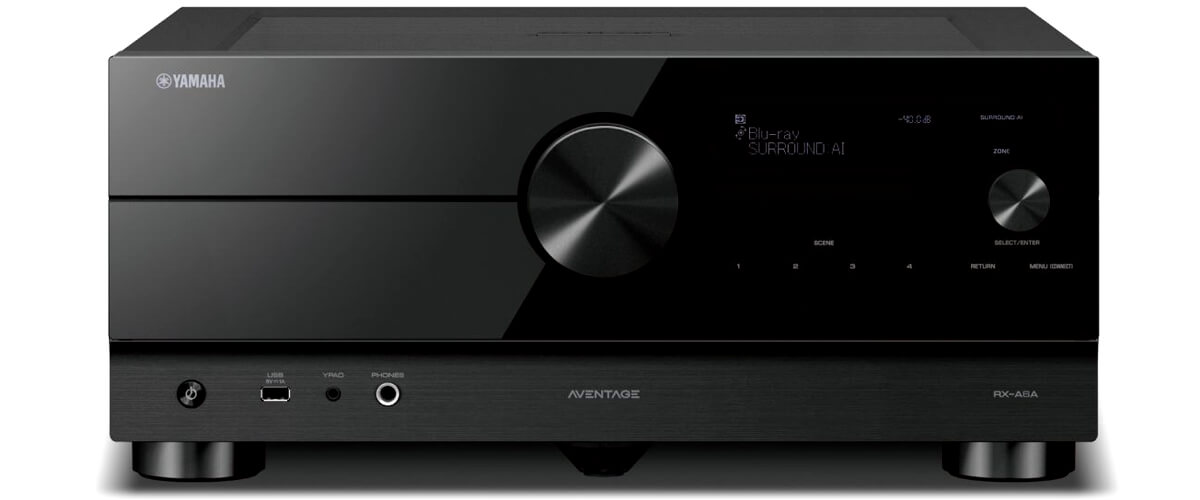
Yamaha made a real noise with their crown jewel Aventage receiver line. They put a lot into the RX-A6A, trying to make it the best 9.2 receiver available on the market. And they partially succeeded. Given its price, one would expect it to be everything, fulfilling every demand one has for the receiver. Accordingly, the company tried to put every possible feature into their device to make it so. They started with a solid and reliable chassis. The RX-6A6 shares it with other models but also features additional anti-vibration dampers and heat sinks to ensure all the electronics operate in a suitable environment.
The unit has 11 pre-outs but independently can work only with 9 channels giving a stunning 185 Watts per 2 channels with 8 ohms speakers and 0.9% THD. Yeah, THD could be a bit lower. On the other hand, they could make a more detailed display. The RX-A6A is not the most expensive receiver in their product line. The top model is RX-A8A, with 11 channels fully packed with every possible technology, but it goes beyond this review. In turn, the receiver goes way above the RX-A4A and RX-A2A, as these two are both seven-channel receivers.
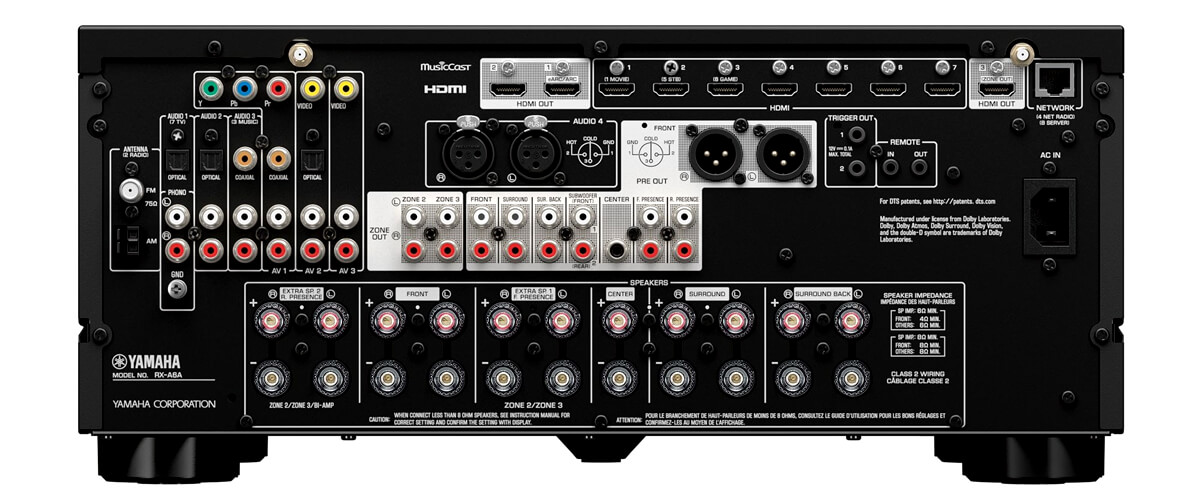
The unit looks like an art when it comes to its specifications. 7 HDMI inputs with the support of 4K at 120Hz and 8K with 60Hz, the full HDR10+ family tech support, Dolby Vision HDR, etc. – this unites the Yamaha RX-A6A with its counterparts from Denon and Marantz, the AVR-X4700H and Marantz SR7015 accordingly. Furthermore, there is an HDMI port with eARC technology support, and typically for this price range, the receiver supports a fully-functional Zone 2 feature.
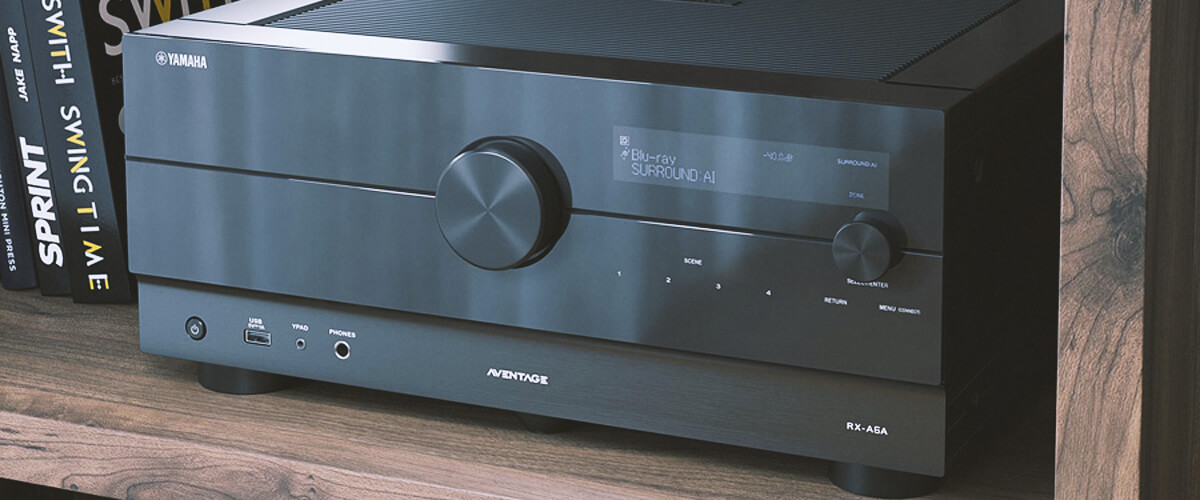
When watching movies, the RX-A6A delivers sound comparable to the mode advanced RX-A8A. It offers nice bass, precise heights, and readable dialogues supplemented by the immersive 9-channel sound. It could have used warmer sound, additional control, and adjustment features, but even right out of the box, it sounds amazing.
Altogether, Yamaha made a great effort with their RX-6A6 adding competition to the receiver market. The unit offers a quality build and pleasant sound quality but lacks right-of-the-box functionality. Plus, Yamaha has a rather unusual design for their devices. Still, The RX-6A6 holds the place among the best 9-channel receivers with honor.
Key specs
- Channels: 9.2.
- Power output: 150W/8 Ohm.
- HDMI inputs/outputs: 7/3.
- Video functions: 8K/60Hz, 4K/60Hz, 4K/120Hz, HDMI Upscaling up to 8K.
- Bluetooth/Wi-Fi: yes/yes.
- Streaming services: AirPlay2, Deezer, Tidal, Pandora, SiriusXM, Napster, SoundCloud, Amazon Music, Amazon Music HD, Mood mix.
- Supports: HDMI ARC, HDMI eARC, HDMI CEC, HDCP2.3, HDR10, HDR10+, Dolby Vision.
- Surround sound: DTS HD Master, DTS Neural:X, Dolby TrueHD, Dolby Surround, Dolby Digital Plus, Dolby Atmos Height Virtualization, Dolby Atmos, Auro-3D.
Pros
- Extensive power.
- Diverse functionality.
Cons
- Some features require an update.
Denon AVR-X3800H
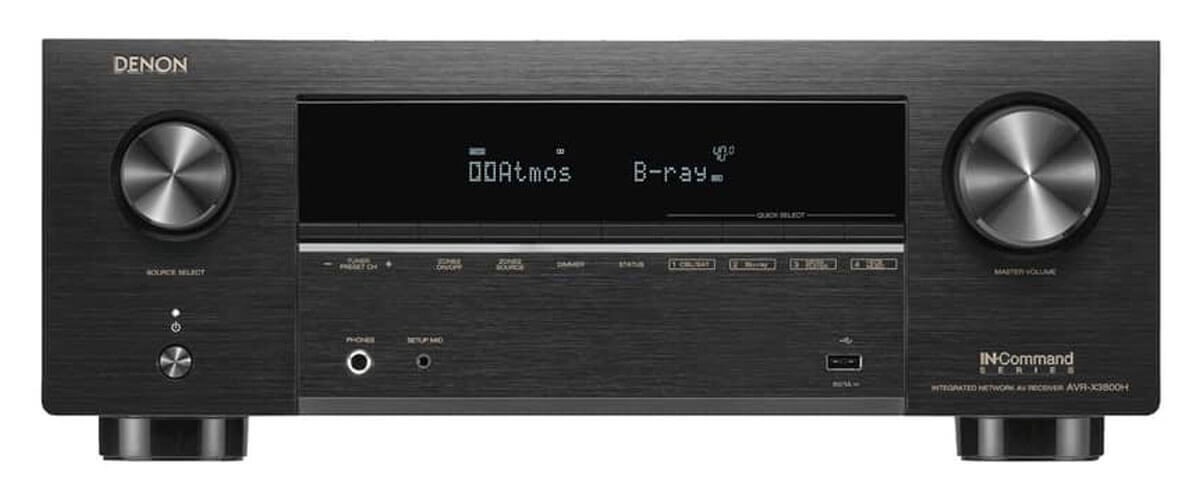
Denon is famous for their fruitful developers. Today, the market is filled with its devices. So, I have included the AVR-X3800H, the second Denon receiver, in my review. And it is not because it looks cool to begin and end the review with Denon products, but because the unit is worth it.
It is a mighty 9.4 channels unit that offers less significant 105 watts per channel with 8 Ohm speakers and supports 11.4 channels processing. While having considerably decreased power than the Yamaha RX-A6A, the receiver offers all the modern features, including Dolby Atmos, IMAX Enhanced, and Auro-3D. Among the most exciting features, the list of audio technologies includes 360 Reality Audio, typical Dolby Surround, Atmos height Virtualization, DTS Neural:X, and DTS Virtual:X.
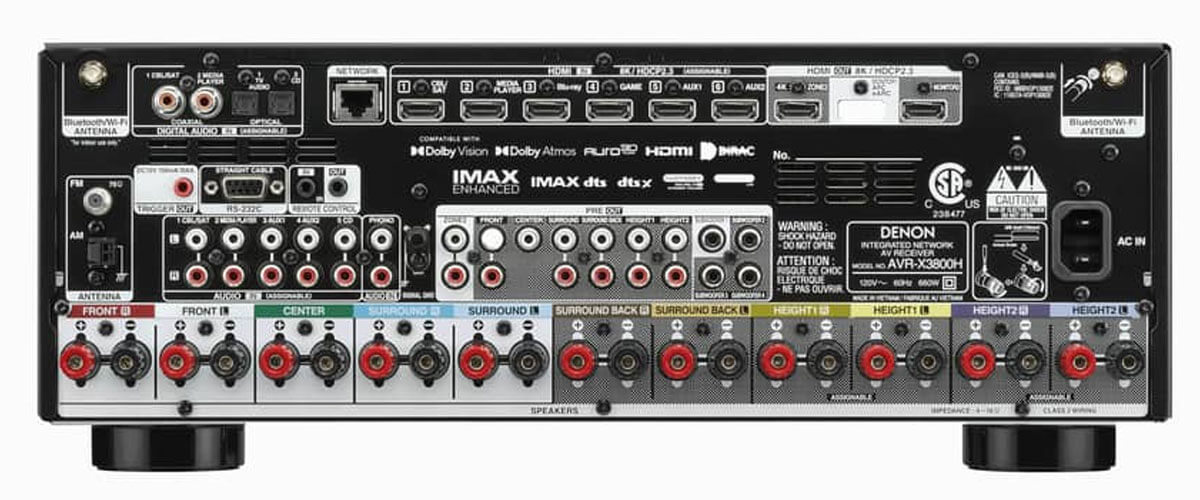
The AVR-X3800H, compared to AVR-X2800H, looks and feels like a totally new unit, even though both models share certain features. Denon did a great job adding multiple features to the receiver, including bi-amping, full Zone 2 support, Advanced Pre-Amplifier Mode, Bluetooth audio, HEOS, AirPlay 2, and voice control. The unit can also automatically set itself up as it has a modern version of Audyssey MultEQ XT32.

When testing sound, I started with its virtual Dolby Atmos Height Virtualization supplemented with DTS Virtual:X. Altogether it was an exciting experience, as the sound from virtual speakers was pretty interesting and capable. Of course, it goes without saying that actual speakers sound much better. Yet, this virtual technology gives a chance to try more advanced surround sound. Talking about problems, the sound sometimes seemed over-processed, which is far from what one would enjoy. I witnessed it both when watching movies and listening to music. On the other hand, it only took to turn off modes, and the sound returned to normal—warm and familiar effects.
The AVR-X3800H has the potential to cut part of the market from other solutions. Yet, it has flaws, and even among Denon’s line, there is a better solution—the AVR-X4700H. It is much more expensive, but it also has more to offer. Or let’s take Onkyo TX-RZ50. It costs even less and is a valuable solution in approximately the same price range as AVR-X3800H unless you are a fan of Denon’s warm and well-perceived sound.
Key specs
- Channels: 9.4.
- Power output: 105W/8 Ohm, 135W/6 Ohm.
- HDMI inputs/outputs: 6/3.
- Video functions: 8K/60Hz, 4K/60Hz, 4K/120Hz, upscaling to 8K.
- Bluetooth/Wi-Fi: yes/yes.
- Streaming services: AirPlay 2, Spotify, TuneIn, Deezer, Tidal, Netflix, Amazon Prime.
- Supports: HDMI ARC, HDMI eARC, HDMI CEC, HDCP2.3, HDR10+, Dolby Vision, 3D Signal Pass-through.
- Surround sound: DTS:X, DTS Neural:X, DTS Virtual:X, Dolby Atmos, DTS HD Master, Dolby TrueHD, Dolby Atmos Height Virtualization, IMAX Enhanced.
Pros
- Typical Denon sound.
- Support of modern technologies.
Cons
- Sometimes sounds too unnatural.
- Costlier than the predecessor.
9.2 receivers buying guide
Choosing an AV receiver is never a trivial thing. Multiple brands offering numerous models is a good thing, but it is also very misleading. Picking up the receiver that won’t let you have bitter grief about a poor choice is truly hard. A good receiver always comes from the equation – your goals and desires, a receiver`s capabilities, and price. In our case, the goal is rather obvious – getting quality sound for a home entertainment system. So, it only remains for me to teach you to read the specs and give a hint on what you exactly need from a receiver to let it meet your goals and expectations.
Power
Brands love to speculate about the power of their units. They tend to mention peak power instead of the actual one, mentioning power per two channels. However, the same receiver can deliver much less than when all channels are used. All this deserves a separate topic, but what is essential to know is that it is more than enough to have about 70-100 watts per channel.
Types of inputs and their number
The second most important aspect is to pay attention to what inputs a receiver offers. It all depends on how and what you will connect to your receiver. Attentively check the number of HDMI ports and types of connectors a receiver has for speakers, subwoofers, the number of coaxial audio, video, analog ports, etc. And remember a simple rule – the more connectivity, the better.
Streaming capabilities
If this is something you plan on actively using, then definitely check whether the receiver supports Wi-Fi or Ethernet, as those are important for online streaming features. Then check if the receiver supports the particular streaming service you plan to use.
Supported resolution and refresh rate
Way too often, I witnessed people buying a modern 8K TV and then saving money on the receiver getting the one with the maximum support of the 4k content. So, make sure that the receiver supports the necessary resolution and can provide the desired refresh rate (Hz). The most popular ones are 4K 60-120Hz and 8K 60Hz.
Surround sound
That’s the main reason why one picks a 9-channel receiver. However, before making the final decision and bringing one of the models home, make sure they support the modern Surround sound formats. The most popular advanced ones are Dolby Atmos and DTS:X. If the unit has them and everything else suits you – you can buy it without a doubt. The list of older surround sound technologies includes Dolby Digital and DTS-HD Master. Those can also provide high-quality immersive sound. But I wouldn’t recommend going lower than this.
FAQ
What is 9.2 channel surround sound?
What’s the difference between 7.1 and 9.1 surround sound?
In addition to the components that make up the 7.1 system, the 9.1 surround sound includes two more front-top speakers. The frontal overhead speakers are placed at the front of the room, directly above the left and right main speakers. They should be about three feet above the left and right front speakers for optimal sound and pointing directly at the listener. Accordingly, this configuration provides a greater surround sound experience.
